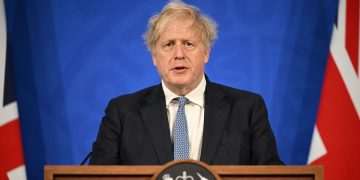As I was photographing Soviet-era monuments in the Lithuanian port city of Klaipėda in May 2022, I heard a woman shout at me: “You are a young Nazi who wants to remove and destroy everything”. She was triggered by my presence, taking notes around the monuments and carrying a couple of professional-looking cameras.
I was in the middle of a research trip to document Soviet monuments in the Baltic states. The past few years had seen some former Soviet bloc countries debate the future of these monuments, many of which were originally erected to mark the role of Soviet forces in the second world war.
Russia’s full-scale invasion of Ukraine, which began earlier in 2022, had accelerated these debates in Lithuania, Latvia and Estonia. The debates were not new – questions about the presence of Soviet-era monuments had surfaced for decades. But concrete actions to remove them had been rare due to divided opinions over their meaning.
For many people in the Baltic states, Soviet-era monuments embodied occupation and served as reminders of repression imposed by a foreign regime. Yet for others, especially within ethnic Russian communities, they continued to represent Soviet wartime victories and functioned as sites of commemoration. Legal restrictions also prevented their removal, as many monuments were formally protected by law.

Kristina van Kuyck, Author provided (no reuse)
These monuments, once largely unquestioned features of the public space, were now being reevaluated against the backdrop of a new war and growing geopolitical tensions. And, as Russia’s aggression in Ukraine continued, the debates over the fate of these monuments intensified. This culminated in direct action.
The first actions often began with acts of vandalism. Monuments, including one in Ukmergė, Lithuania, which had been unveiled in 1982 to mark the 60th anniversary of the Soviet Union, were defaced. They were frequently covered in blue and yellow paint, reflecting the scale of public anger at the war and solidarity with Ukraine.

Kristina van Kuyck, Author provided (no reuse)
These spontaneous interventions were soon followed by more formal, centralised action. Local municipalities held meetings to discuss relocating monuments, while some took steps to remove them altogether.
Lithuania’s parliament passed a so-called desovietisation law in late 2022. This banned the commemoration or representation of people, symbols and information promoting totalitarian or authoritarian regimes and their ideologies. Latvia’s parliament also passed a law providing for the dismantling of sites glorifying Soviet and Nazi regimes.
Where decision-making stalled and legal restrictions prevented official action, local communities often took matters into their own hands. In some cases, such as in the Lituanian city of Telšiai, Soviet war memorials were covered with garbage bags. This deprived them of their symbolic presence without physically removing them.

Kristina van Kuyck, Author provided (no reuse)
Public opinion on the removal of monuments was far from uniform. A 2022 survey revealed that 50% of the Lithuanian population supported the removal of Soviet monuments (21% “fully support” and 29% “rather agree”), while 35% opposed it. Nevertheless, Soviet monuments rapidly disappeared from public spaces in the Baltic states following Russia’s invasion, leaving a visible mark on the urban landscape.
Documenting these monuments in 2022 proved challenging as removals were progressing at a rapid pace. In some cases, monuments were taken down without prior public notice to avoid disruption. Sometimes, I arrived at sites just too late. One of the first memorials to fall in Latvia was located in the south-eastern city of Jēkabpils, which I reached when dismantling was already underway.
In a few of the more high-profile cases, such as the monument in the Latvian capital Riga – to the Liberators of Soviet Latvia and Riga from German Fascist Invaders – sites were fenced off and monitored by police.

Kristina van Kuyck, Author provided (no reuse)
Three years on
Visiting the same sites in the summer of 2025, I observed several patterns in the changing urban landscape. Some former monument sites still bore traces of the Soviet legacy, leaving noticeable voids in the public space. In Ukmergė, for example, the monument itself had been removed, but the surrounding site remained largely untouched. In Narva, an Estonian border city, the obelisk topped with a five-pointed star had been taken down. This left only an empty plinth as a silent reminder of what once stood there.
Such cases are common in peripheral towns, where removals often occurred without follow-up plans or allocated funds for redevelopment.

Kristina van Kuyck, Author provided (no reuse)

Kristina van Kuyck, Author provided (no reuse)
Even after removal, some former sites continued to serve as places of memory for local Russian-speaking communities. In Vilnius, the capital of Lithuania, a monument comprised of six granite statues of Soviet soldiers was taken down in late December 2022.
Yet the site still provides space for commemorations, with a lit candle and a wreath placed where the monument once stood. The statues have been relocated to Grūtas Park, a Soviet sculpture park in Lithuania, where they are placed in the parking lot with a lantern symbolising an eternal flame.

Kristina van Kuyck, Author provided (no reuse)

Kristina van Kuyck, Author provided (no reuse)
Other former Soviet-era monument sites reveal striking transformations. A park in Pärnu, south-western Estonia, and a public square in Daugavpils, south-eastern Latvia, now show no visible traces of the monuments that once occupied a space in the urban landscape there.

Kristina van Kuyck, Author provided (no reuse)

Kristina van Kuyck, Author provided (no reuse)
I had to return twice, circling the park in Pärnu, before I could recognise the spot where I had photographed the monument three years earlier. These monuments have slipped into a silent oblivion.

Kristina van Kuyck, Author provided (no reuse)

Kristina van Kuyck, Author provided (no reuse)
Many of the Soviet-era monuments were originally placed within military cemeteries where Soviet soldiers were buried. Usually, these cemeteries were maintained by Russian embassies. However, with the monuments gone – and their role as visual propaganda erased – many of the sites have been left neglected. Their upkeep is faltering alongside their symbolic power.

Kristina van Kuyck, Author provided (no reuse)
The war in Ukraine has triggered striking changes in the urban landscape across the Baltic states. These changes reveal not a uniform story of erasure but rather a fragmented landscape of memory.
My photographs show how some places are marked by absences, others are inscribed with different meanings, and many have fallen into neglect.


















































